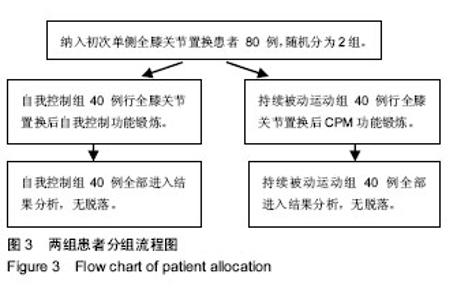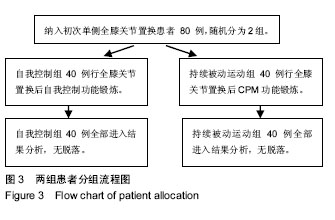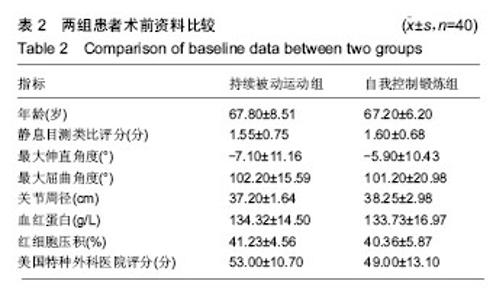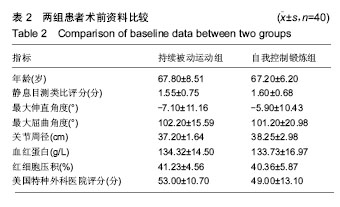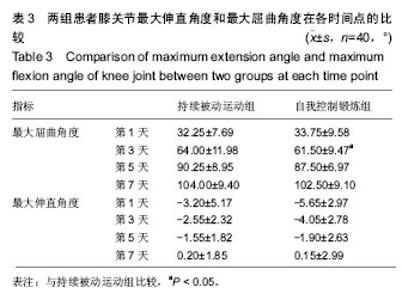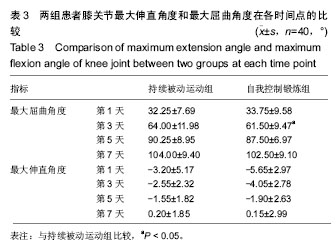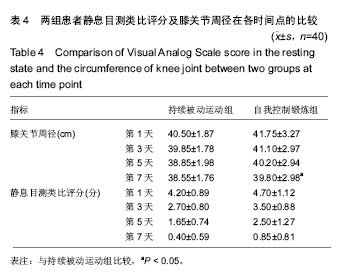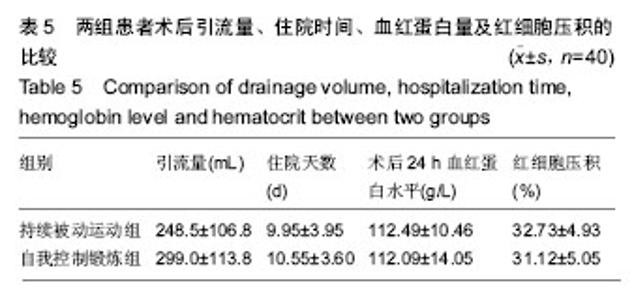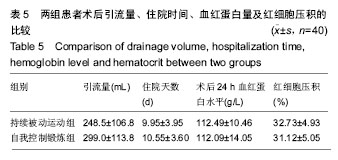Chinese Journal of Tissue Engineering Research ›› 2019, Vol. 23 ›› Issue (20): 3130-3135.doi: 10.3969/j.issn.2095-4344.1234
Previous Articles Next Articles
Self-control versus continuous passive motion exercise following primary total knee arthroplasty
Zhang Hui1, Liu Biquan1, Li Hong1, Liu Jingjun1, Gan Yuyun1, Li Lunlan2, Yin Zongsheng1
- 1Department of Joint Surgery, 2Department of Nursing, the First Affiliated Hospital of Anhui Medical University, Hefei 230022, Anhui Province, China
-
Online:2019-07-18Published:2019-07-18 -
About author:Zhang Hui, MD, Associate chief physician, Department of Joint Surgery, the First Affiliated Hospital of Anhui Medical University, Hefei 230022, Anhui Province, China -
Supported by:the Natural Science Foundation of Anhui Province, No. 1508085MH183 (to LLL); the Natural Science Research of Universities in Anhui Province, No. KJ2018A0662 (to ZH)
CLC Number:
Cite this article
Zhang Hui, Liu Biquan, Li Hong, Liu Jingjun, Gan Yuyun, Li Lunlan, Yin Zongsheng. Self-control versus continuous passive motion exercise following primary total knee arthroplasty[J]. Chinese Journal of Tissue Engineering Research, 2019, 23(20): 3130-3135.
share this article
| [1] Longo UG, Ciuffreda M, Mannering N, et al. Outcomes of posterior-stabilized compared with cruciate-retaining total knee arthroplasty.J Knee Surg. 2018;31(4):321-340. [2] Wylde V, Dennis J, Gooberman-Hill R, et al.Effectiveness of postdischarge interventions for reducing the severity of chronic pain after totalknee replacement: systematic review of randomised controlled trials.BMJ Open. 2018;8(2): e020368. [3] Liao CD, Huang YC, Lin LF, et al.Continuous passive motion and its effects on knee flexion after total knee arthroplasty in patients with knee osteoarthritis.Knee Surg Sports Traumatol Arthrosc. 2016;24(8):2578-25 86.[4] Liu CY, Li CD, Wang L, et al. Function scores of different surgeries in the treatment of knee osteoarthritis: A PRISMA-compliant systematic review and network-meta analysis. Medicine (Baltimore). 2018 ;97(21):e10828.[5] Mont MA, Beaver WB, Dysart SH, et al. Local infiltration analgesia with liposomal bupivacaine improves pain scores and reduces opioid use after total knee arthroplasty: results of a randomized controlled trial. J Arthroplasty. 2018;33(1): 90-96.[6] Price AJ, Alvand A, Troelsen A, et al. Knee replacement.Lancet. 2018;392(10158):1672-1682. [7] Mistry JB, Elmallah RD, Bhave A, et al. Rehabilitative guidelines after total knee arthroplasty: a review. J Knee Surg. 2016;29(3):201-217.[8] Peter WF, Nelissen RG, Vlieland TP. Guideline recommendations for post-acute postoperative physiotherapy in total hip and knee arthroplasty: are they used in daily clinical practice? Musculoskeletal Care. 2014;12(3):125-131.[9] Jahic D, Omerovic D, Tanovic AT, et al.The Effect of Prehabilitation on Postoperative Outcome in Patients Following Primary Total Knee Arthroplasty.Med Arch. 2018; 72(6):439-443.[10] Hyodo K, Masuda T, Aizawa J,et al.Hip, knee, and ankle kinematics during activities of daily living: a cross-sectional study.Braz J Phys Ther. 2017;21(3):159-166. [11] Chaudhry H, Bhandar M.Cochrane in CORR (®): Continuous Passive Motion Following Total Knee Arthroplasty in People With Arthritis (Review). Clin Orthop Relat Res. 2015;473(11): 3348-3354. [12] Harvey LA, Brosseau L, Herbert RD. Continuous passive motion following total knee arthroplasty in people with arthritis.Cochrane Database Syst Rev. 2014;(2):CD004260. [13] Doll H, Gentile B, Bush EN, et al. Evaluation of the measurement properties of four performance outcome measures in patientswith elective hip replacements, elective knee replacements, or hip fractures. Value Health. 2018 ; 21(9):1104-1114[14] Nagra NS, Hamilton TW, Strickland L, et al. Enhanced recovery programmes for lower limb arthroplasty in the UK. Ann R Coll Surg Engl. 2017:1-6.[15] Schache MB, McClelland JA, Webster KE. Does the addition of hip strengthening exercises improve outcomes following total knee arthroplasty? A study protocol for a randomized trial. BMC Musculoskelet Disord. 2016;17:259.[16] Boese CK, Weis M, Phillips T, et al. The efficacy of continuous passive motion after total knee arthroplasty: a comparison of three protocols.J Arthroplasty. 2014;29(6):1158-1162. [17] Tedesco D, Gori D, Desai KR, et al.Drug-Free Interventions to Reduce Pain or Opioid Consumption After Total Knee Arthroplasty: A Systematic Review and Meta-analysis.JAMA Surg. 2017;152(10):e172872. [18] Maniar RN, Baviskar JV, Singhi T, et al.To use or not to use continuous passive motion post-total knee arthroplasty presenting functional assessment results in early recovery. J Arthroplasty. 2012;27(2):193-200.e1. [19] Boese CK, Weis M, Phillips T, et al.The efficacy of continuous passive motion after total knee arthroplasty: a comparison of three protocols.J Arthroplasty. 2014;29(6):1158-1162.[20] Jiang C, Lou J, Qian W, et al. Impact of flexion versus extension of knee position on outcomes after total knee arthroplasty: a meta-analysis. Arch Orthop Trauma Surg. 2017 ;137(2):257-265.[21] Schache MB, McClelland JA, Webster KE. Does the addition of hip strengthening exercises improve outcomes following total knee arthroplasty? A study protocol for a randomized trial.BMC Musculoskelet Disord. 2016;17:259.[22] Liu J, Li YM, Cao JG,et al.Effects of knee position on blood loss following total knee arthroplasty: a randomized, controlled study. J Orthop Surg Res. 2015;10:69.[23] Graham JE, Granger CV, Karmarkar AM, et al.The Uniform Data System for Medical Rehabilitation: report of follow-up information on patients discharged from inpatient rehabilitation programs in 2002-2010.Am J Phys Med Rehabil. 2014;93(3):231-244. [24] Bak?rhan S, Ünver B, Karatosun V. Effects of two different continuous passive motion protocols on the functional activities of total knee arthroplasty inpatients.Acta Orthop Traumatol Turc. 2015;49(5):497-502.[25] Fitz W, Shukla P, Li L, et al. Early Regain of Function and Proprioceptive Improvement Following Knee Arthroplasty.Arch Bone Jt Surg. 2018;6(6):523-531.[26] Knapik DM, Harris JD, Pangrazzi G,et al.The basic science of continuous passive motion in promoting knee health: a systematic review of studies in a rabbit model. Arthroscopy. 2013;29(10):1722-1731.[27] Herbold JA, Bonistall K, Blackburn M. Effectiveness of continuous passive motion in an inpatient rehabilitation hospital after total knee replacement: a matched cohort study.PM R. 2012;4(10):719-725. [28] Tarakji BA, Wynkoop AT, Srivastava AK, et al. Improvement in depression and physical health following total joint arthroplasty. J Arthroplasty. 2018;33(8):2423-2427.[29] Lisi C, Caspani P, Bruggi M, et al. Early rehabilitation after elective total knee arthroplasty. Acta Biomed. 2017;88(4S):56-61. |
| [1] | Huang Dengcheng, Wang Zhike, Cao Xuewei. Comparison of the short-term efficacy of extracorporeal shock wave therapy for middle-aged and elderly knee osteoarthritis: a meta-analysis [J]. Chinese Journal of Tissue Engineering Research, 2021, 25(9): 1471-1476. |
| [2] | Li Dadi, Zhu Liang, Zheng Li, Zhao Fengchao. Correlation of total knee arthroplasty efficacy with satisfaction and personality characteristics [J]. Chinese Journal of Tissue Engineering Research, 2021, 25(9): 1346-1350. |
| [3] | Wei Wei, Li Jian, Huang Linhai, Lan Mindong, Lu Xianwei, Huang Shaodong. Factors affecting fall fear in the first movement of elderly patients after total knee or hip arthroplasty [J]. Chinese Journal of Tissue Engineering Research, 2021, 25(9): 1351-1355. |
| [4] | Lü Zhen, Bai Jinzhu. A prospective study on the application of staged lumbar motion chain rehabilitation based on McKenzie’s technique after lumbar percutaneous transforaminal endoscopic discectomy [J]. Chinese Journal of Tissue Engineering Research, 2021, 25(9): 1398-1403. |
| [5] | Gao Yan, Zhao Licong, Zhao Hongzeng, Zhu Yuanyuan, Li Jie, Sang Deen. Alteration of low frequency fluctuation amplitude at brain-resting state in patients with chronic discogenic low back pain [J]. Chinese Journal of Tissue Engineering Research, 2021, 25(8): 1160-1165. |
| [6] | Wu Gang, Chen Jianwen, Wang Shilong, Duan Xiaoran, Liu Haijun, Dong Jianfeng. Simple HyProCure subtalar stabilization in treatment of adolescent flexible flatfoot combined with painful accessory navicular bone [J]. Chinese Journal of Tissue Engineering Research, 2021, 25(6): 901-905. |
| [7] | Li Yan, Wang Pei, Deng Donghuan, Yan Wei, Li Lei, Jiang Hongjiang. Electroacupuncture for pain control after total knee arthroplasty: a meta-analysis [J]. Chinese Journal of Tissue Engineering Research, 2021, 25(6): 957-963. |
| [8] | Zhao Zhongyi, Li Yongzhen, Chen Feng, Ji Aiyu. Comparison of total knee arthroplasty and unicompartmental knee arthroplasty in treatment of traumatic osteoarthritis [J]. Chinese Journal of Tissue Engineering Research, 2021, 25(6): 854-859. |
| [9] | Zhang Nianjun, Chen Ru. Analgesic effect of cocktail therapy combined with femoral nerve block on total knee arthroplasty [J]. Chinese Journal of Tissue Engineering Research, 2021, 25(6): 866-872. |
| [10] | Li Quanxi, Shen Yu, Wan Wei, Sun Shanzhi. Changes of abdominal wall mechanics and pain after tension-free inguinal hernia repair with polypropylene mesh [J]. Chinese Journal of Tissue Engineering Research, 2021, 25(4): 548-552. |
| [11] | Wang Xiaofei, Teng Xueren, Cong Linyan, Zhou Xu, Ma Zhenhua. Herbert screw internal fixation for treating adult osteochondritis dissecans of the knees [J]. Chinese Journal of Tissue Engineering Research, 2021, 25(3): 397-402. |
| [12] | Li Kun, Li Zhijun, Zhang Shaojie, Gao Shang, Sun Hao, Yang Xi, Wang Xing, Dai Lina . A 4-year-old child model of occipito-atlanto-axial joints established by finite element dynamic simulation [J]. Chinese Journal of Tissue Engineering Research, 2021, 25(24): 3773-3778. |
| [13] | Zhang Qifu, Ma Yonghong, Wang Tao, Hu Yibo, Zhang Heling, Zong Qunchuan. Effects of anterior corpectomy and fusion versus posterior single open-door laminoplasty on cervical range of motion of patients with multilevel cervical spondylotic myelopathy [J]. Chinese Journal of Tissue Engineering Research, 2021, 25(24): 3870-3874. |
| [14] | Yang Wei, Chen Zehua, Yi Zhiyong, Huang Xudong, Han Qingmin, Zhang Ronghua. Effectiveness of intra-articular injection of hyaluronic acid versus placebo in the treatment of early and mid-stage knee osteoarthritis: a Meta-analysis based on randomized, double-blind, controlled, clinical trials [J]. Chinese Journal of Tissue Engineering Research, 2021, 25(23): 3760-3766. |
| [15] | Liu Chang, Li Datong, Liu Yuan, Kong Lingbo, Guo Rui, Yang Lixue, Hao Dingjun, He Baorong. Poor efficacy after vertebral augmentation surgery of acute symptomatic thoracolumbar osteoporotic compression fracture: relationship with bone cement, bone mineral density, and adjacent fractures [J]. Chinese Journal of Tissue Engineering Research, 2021, 25(22): 3510-3516. |
| Viewed | ||||||
|
Full text |
|
|||||
|
Abstract |
|
|||||
